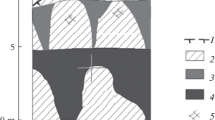Summary
From water of the Baltic Sea a bacterium has been isolated which reproduces by budding and by multiple fission of coccoid units, thus giving rise to a variety of cell forms and aggregates, which so far have not been known in any bacterial genus. It is a heterotrophic, motile, grampositive organism, which grows best in brackish water media. This paper deals with morphological, cytological, and physiological characters and with the possible taxonomic position of the organism.
Zusammenfassung
Aus Wasser der Ostsee wurde ein Bakterium isoliert, das durch Knospung sowie durch Mehrfachteilung kokkenähnlicher Einheiten eine Vielfalt von Zellformen und-aggregaten ausbildet, wie sie bisher in keiner Bakteriengattung bekannt sind. Es handelt sich um einen heterotrophen beweglichen grampositiven Brackwasserorganismus. Die vorliegende Arbeit behandelt morphologische, cytologische und physiologische Merkmale sowie die mögliche taxonomische Stellung des Organismus.
Similar content being viewed by others
Literatur
Ahrens, R.: Taxonomische Untersuchungen an sternbildenden Agrobacterium-Arten aus der westlichen Ostsee. Kieler Meeresforsch. 24, 147–173 (1968).
—, Rheinheimer, G.: Über einige sternbildende Bakterien aus der Ostsee. Kieler Meeresforsch. 23, 127–136 (1967).
—: Bergey's Manual of Determinative Bacteriology, 7. Aufl. Hrsg.: R. S. Breed, E. G. D. Murray, and N. R. Smith. Baltimore: The Williams & Wilkins Comp., 1957.
Conti, S. F., Hirsch, P.: Biology of budding bacteria. III. Fine structure of Rhodomicrobium and Hyphomicrobium spp. J. Bact. 89, 503–512 (1965).
Drews, G., Giesbrecht, P.: Der Aufbau der Bakterien- und Cyanophyceenzelle. In: Die Zelle, Struktur und Funktion, S. 57–106. Hrsg.: H. Metzner. Stuttgart: Wissenschaftliche Verlagsgesellschaft m. b. H., 1966.
Giesbrecht, P.: Über „organisierte” Mitochondrien und andere Feinstrukturen von Bacillus megaterium. Zbl. Bakt., I. Abt. Orig. 179, 538–582 (1960).
—: Vergleichende Untersuchungen an den Chromosomen des Dinoflagellaten Amphidinium elegans und denen der Bakterien. Zbl. Bakt., I. Abt. Orig. 187, 452–475 (1962).
Glauert, A. M., Hopwood, D. A.: The fine structure of Streptomyces violaceoruber (S. coelicolor). J. biophys. biochem. Cytol. 10, 505–516 (1961).
Hirsch, P., Conti, S. F.: Biology of budding bacteria. I. Enrichment, isolation and morphology of Hyphomicrobium spp. Arch. Mikrobiol. 48, 339–357 (1964).
Hopwood, D., Glauert, A. M.: The fine structure of Streptomyces coelicolor. II. The nuclear material. J. biophys. biochem. Cytol. 8, 267–278 (1960).
Iterson, W., van: Some features of a remarkable organelle in Bacillus subtilis. J. biophys. biochem. Cytol. 9, 183–192 (1961).
—: Die Feinstruktur der Bakterienzelle. Mikroskopie 21, 107–121 (1966).
Krassilnikov, N. A.: Diagnostik der Bakterien und Actinomyceten. Jena: Fischer, 1959.
Masaatsu, K., Takeya, K.: Fine structure of intracytoplasmic organelles of Mycobacteria. J. biophys. biochem. Cytol. 9, 597–608 (1961).
Moll, G., Ahrens, R., Rheinheimer, G.: Elektronenoptische Untersuchungen über sternbildende Bakterien aus der Ostsee. Kieler Meeresforsch. 23, 137–147 (1967).
Mudd, S.: Cellular organization in relation to function. Bact. Rev. 20, 268–271 (1956).
Oppenheimer, C. H., ZoBell, C. E.: The growth and viability of sixty-three species of marine bacteria as influenced by hydrostatic pressure. J. Marine Res. 11, 10 (1952).
Rheinheimer, G.: Mikrobiologische Untersuchungen in der Elbe zwischen Schnakkenburg und Cuxhaven. Arch. Hydrobiol. Suppl. Elbe-Aestuar XXIX/II, 181–251 (1965).
Ryter, A., Jacob, F.: Etude au microscope électronique de la liaison entre noyau et mésosome chez Bacillus subtilis. Ann. Inst. Pasteur 107, 384–400 (1964).
Schmidt, J., Stanier, R. Y.: The development of cellular stalks in bacteria. J. Cell Biol. 28, 423–436 (1966).
Shinohara, C., Fukushi, K., Suzuki, J.: Mitochondrial structure of Mycobacterium tuberculosis relating to its function. J. Electronmicroscopy 6, 47–52 (1958).
Stove Poindexter, J.: Biological properties and classification of the Caulobacter group. Bact. Rev. 28, 231–295 (1964).
—, Cohen-Bazire, G.: The fine structure of stalked bacteria belonging to the family Caulobacteriaceae. J. Cell Biol. 23, 587–607 (1964).
Thompson, R. E. M.: A species of Rhizobium isolated from strawberry foot-rot in the sheep. J. Path. Bact. 68, 445–452 (1954).
—, Bisset, K. A.: Polysepta: a new genus and suborder of bacteria. Nature (Lond.) 179, 590–591 (1957).
Whittenbury, R., McLee, A. G.: Rhodopseudomonas palustris and Rh. viridis—photosynthetic budding bacteria. Arch. Mikrobiol. 59, 324–334 (1967).
Author information
Authors and Affiliations
Rights and permissions
About this article
Cite this article
Ahrens, R., Moll, G. Ein neues knospendes Bakterium aus der Ostsee. Archiv. Mikrobiol. 70, 243–265 (1970). https://doi.org/10.1007/BF00407714
Received:
Issue Date:
DOI: https://doi.org/10.1007/BF00407714




